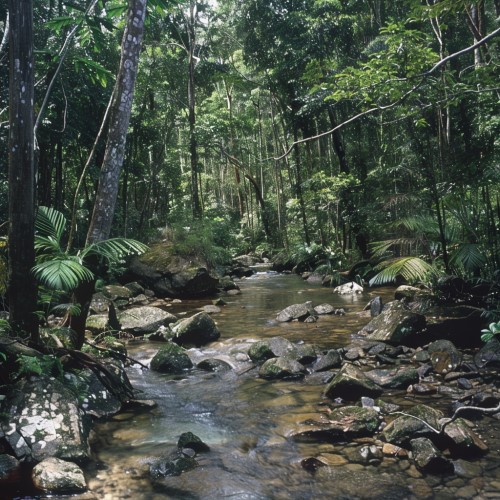KidZone Habitats
Introduction to the Concept of Habitats:
 What is a Habitat?: A habitat is like a big, natural home where plants and animals live. It provides them everything they need: food, water, shelter, and a safe place to raise their young ones.
What is a Habitat?: A habitat is like a big, natural home where plants and animals live. It provides them everything they need: food, water, shelter, and a safe place to raise their young ones.- Types of Habitats: There are different types of habitats, such as forests, deserts, oceans, rainforests, tundras, and mountains. Just like our homes are different, animals and plants have homes that best suit their needs.
- Habitat Features: There are some important features of habitats - water (rivers, lakes, oceans), food (plants, other animals), shelter (trees, caves, coral reefs), air (clean and breathable), and safe places for raising young (nests, burrows).
- Interdependence: Animals, plants, and their environment depend on each other to survive, creating a balanced community.
- Habitats vs Ecosystems: A habitat is where an organism lives, and an ecosystem is how it lives in relation to other organisms and the environment.
- Adaptations: Animals and plants have special features (adaptations) that help them live in their specific habitat, like a polar bear's thick fur for cold climates or a cactus's ability to store water in the desert.
- Human Impact: Humans can affect habitats positively by protecting them and negatively through pollution and deforestation.
- Fun Facts: Interesting and fun facts about different habitats to spark curiosity.
- Activities for Young Children (Preschool to Grade 2)
- Advanced Information About Habitats: Information for older grades.
- Activities for Older Children (Grades 3 to 6)
 Printables:
Printables:
Types of Habitats:
 Arctic Tundra
Arctic Tundra

In the chilly Arctic Tundra, the ground is frozen year-round in a layer called permafrost, creating a unique landscape for hardy wildlife.
 Daintree Rainforest
Daintree Rainforest

The ancient Daintree Rainforest, teeming with diverse life, is one of the oldest rainforests on Earth, dating back over 135 million years.
 Great Barrier Reef
Great Barrier Reef

The Great Barrier Reef, visible from space, dazzles with its vibrant underwater kaleidoscope of coral and marine life.
 Mojave Desert
Mojave Desert

The Mojave Desert transforms at night, cooling down and becoming a lively stage for nocturnal animals under the starlit sky.
 Rocky Mountains
Rocky Mountains

Towering high, the Rocky Mountains are home to ancient bristlecone pines, some of the oldest living trees on our planet.
 Amazon Rainforest
Amazon Rainforest

The largest rainforest on Earth, full of vibrant wildlife, towering trees, and mysterious creatures, offering endless opportunities for exploration and learning about biodiversity.
Here are a few more specific and interesting habitats that can captivate young children:
- Serengeti Plains: Located in East Africa, known for its vast, open grasslands and the spectacular annual migration of wildebeest and other grazing herbivores.
- Antarctic Peninsula: Offering a stark, icy landscape home to penguins, seals, and whales, it provides a contrasting environment to the Arctic and introduces children to polar research and conservation efforts.
- Sonoran Desert: Known for the iconic Saguaro cactus, this North American desert is rich in biodiversity and showcases how life adapts to extreme heat and aridity.
- Congo Basin Rainforest: The second-largest rainforest in the world, located in Central Africa, teeming with gorillas, elephants, and a vast array of tropical flora and fauna.
- Redwood Forests: Found along the coast of northern California, these forests are home to the tallest trees on Earth, offering a perspective on conservation and the importance of old-growth forests.
- Madagascar Spiny Forests: Unique for their bizarre and drought-resistant plants, including various species of baobab trees and spiny forests, housing many species found nowhere else on Earth.
- Galápagos Islands: Famous for their unique species that helped Charles Darwin formulate his theory of evolution, this volcanic archipelago offers a living laboratory for studying adaptation and natural selection.
These habitats not only introduce children to the wonders of nature but also help instill an appreciation for the environment and the need for conservation from a young age. Each habitat provides a unique story about the planet's biodiversity and the interconnections within ecosystems, making them exciting topics for young learners.
The fact that some regions can be a suitable habitat for a variety of plant and animal species is what makes these areas a community. In this way, some species work together in order to make an area a suitable habitat. We, as humans, need to remember that we're part of the community we call Earth!

Other links you might enjoy:
- DLTK's Animal Activities (crafts, coloring, recipes and more)
- Kidzone Geography - includes different plant and animal species